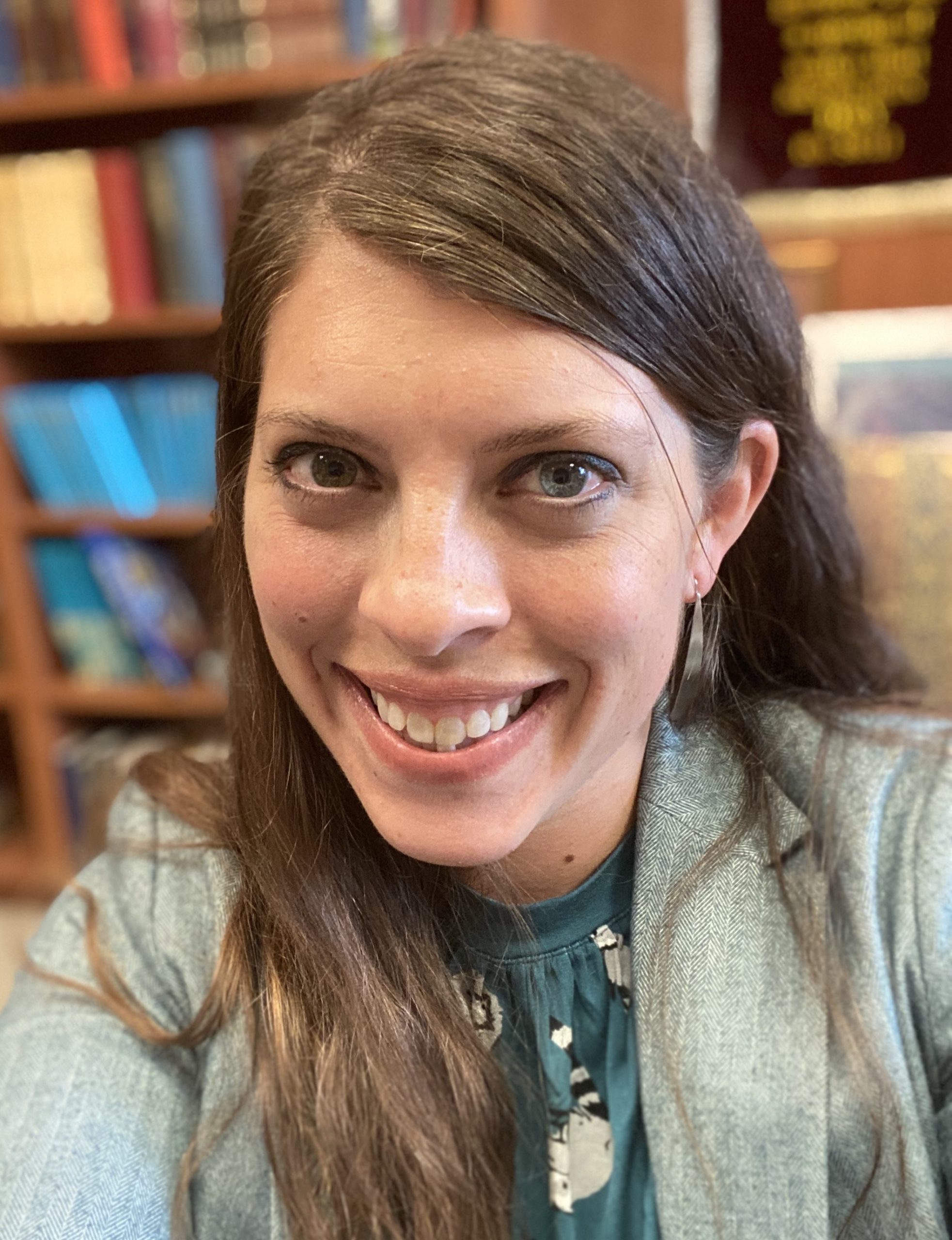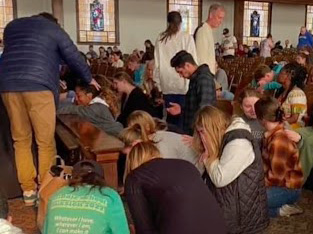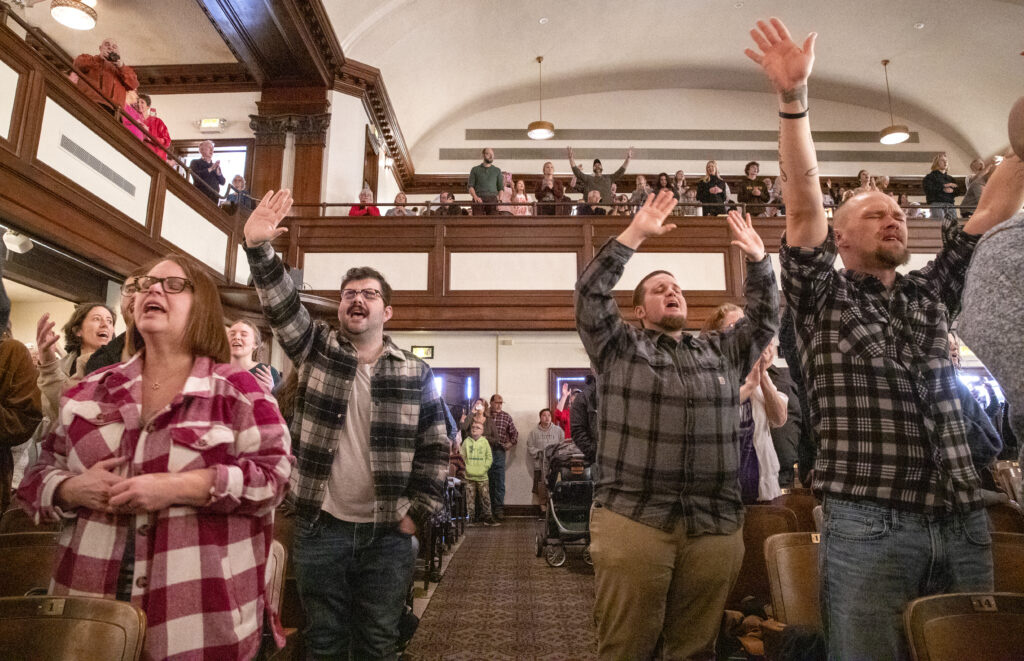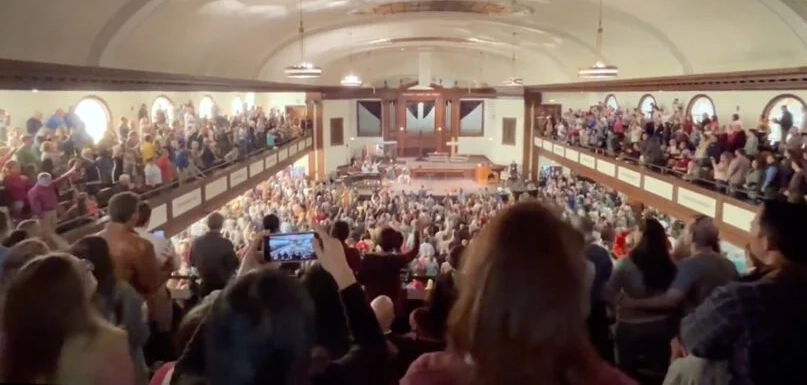Not every experience of God occurs in a revival. But revivals are perennial in American Christianity.
In the past, they have made their mark upon the social landscape and changed daily Christian habits. There is the “Burned Over District” in upstate New York, burnt from the wild excitement of participants and the new religious movements that sprang up in its wake.
Political movements like temperance and slavery abolition also grew from revival energy. Denominations intent on reforming church worship, culture and practices have spawned from revival, whether from the rural farmland of Cane Ridge, Ky., that sprouted the Restorationist movement in 1801, urban Los Angeles Azusa Street that propelled Pentecostalism in the early 1900s, or the Asbury University campus revivals that boosted youth and young adult focused evangelism in the 1970s.

Laura Levens
If your church congregation practices any form of the altar call during Sunday morning worship, that is one sign your experience of Christianity is shaped by remnants of revival. Both fire-and-brimstone Calvinist preaching and the rhythm of Methodist and Wesleyan prayer meetings have watered the ground, preparing for several revivals over the past 250 years.
There are other signs, as revival — and reaction against it — has shaped portions of American culture at large. Sister Rosetta Tharpe played for revivals before she became the “first guitar heroine of rock and roll.”
The current “Asbury revival” has been happening for about seven days now. There are debates over whether or not to call it a “revival,” and further debates over what are the marks of a “true revival” and its outcomes. I am a professor of Christian mission, and to state what is now obvious, I have studied quite a bit of revival history, and this makes me very hesitant to pass judgment over that debate.
True revival/true religion
I have found that inside every debate over “true revival,” much like debates over “true religion,” are obvious and more subtle expectations of class, gender, race and spirituality.
“Revivals, if anything, are mixed and messy on all these accounts.”
And revivals, if anything, are mixed and messy on all these accounts. There is a break of social norms and decorum, both in obvious and other subtle ways. At the same time, people are creatures of habit and will bring their religious habits and theologies and behaviors into the revival space. The push and pull of remembering norms and the breaking of all norms are part and parcel of most revival spaces — especially those like Asbury that overextend expectations of time.
I visited the revival at Asbury University on Tuesday, Feb. 14. I arrived mid-morning, and when I entered Hughes Chapel, the entire crowd was bathed in soft, golden light. Two-story, buttery yellow stained-glass windows cast everything and everyone with a serene glow like an eternal sunset.
Everything on stage was an intentionally low-fi production during my two-and-a-half-hour stay. Three people were on stage, singing and playing music. They gently rocked and sang softly as they played guitar and piano. A large drum kit and the stately organ pipes went unused. A few art pieces dotted the stage. The projector screens were closed up; no words to the music were provided. Two crosses made with plain wooden boards and posts were displayed. Worship leaders changed places seamlessly.
Revival without a name
I know none of their names because they weren’t introduced. Hence Asbury’s claim it is a revival without a name.
On the floor and in the balcony, there were all ages of people. Seniors in college sitting in front of senior citizens. Families with multiple children, rows of teenagers, babies, men in their early thirties, college athletes — and so many of these people were singing. They sang widely used praise and worship songs, as old as Jesus Culture and as recent as Hillsong, with a few hymns important to the Asbury students mixed in.
People streamed in and out at all times. Circles of people gathered just outside in hallways and on the steps in whispered prayer. If there can be both a hush and great sound at the same time, they were there, intermingling among the crowds. Audible signals of the push and pull of habit and change, of breaking of norms and renewing and reinforcing of old ways once forgotten or disdained.
 Standing by with tables full of snacks, water and QR codes for those in need of beds, unnamed women watched and waited by the doors to offer food and care to anyone who walked in the door. They acted as if they had supplied food and water and beds and care for bodily and spiritual needs many times in their lives. The food and beds were donated from the Wilmore community and parents of students. Women pulled up in their vans with recent purchases from Costco. Homemade barbeque and buns appeared in the back for the volunteers. Someone had left a beautiful, highly valuable cloth from Sierra Leone for the worship leaders.
Standing by with tables full of snacks, water and QR codes for those in need of beds, unnamed women watched and waited by the doors to offer food and care to anyone who walked in the door. They acted as if they had supplied food and water and beds and care for bodily and spiritual needs many times in their lives. The food and beds were donated from the Wilmore community and parents of students. Women pulled up in their vans with recent purchases from Costco. Homemade barbeque and buns appeared in the back for the volunteers. Someone had left a beautiful, highly valuable cloth from Sierra Leone for the worship leaders.
QR codes were distributed for sharing testimony. Dry erase boards were covered with brightly colored prayer requests. People prayed for the sick, for the salvation of Kentucky and other regions of the world, against spiritual warfare. They prayed over trauma, body issues, broken relationships, inclusion of marginalized students. There are hints of struggle with purity culture and body image on the boards.
“There is outright prayer over the harms committed by the church.”
There is outright prayer over the harms committed by the church. I learned that a few days earlier, a student wrote a prayer for acceptance of the sacred worth of queer students that was anonymously and harshly rubbed out, only to be rewritten on the board by someone else later in the night.
Whoever is taking care of these boards remains in the background, blending in with the nameless women serving food. Volunteers from Asbury staff and faculty stand casually among the people and also in strategic places to help with prayer at the altar rail, with seating and to guard the stage.
When I asked who was in charge, I was told, “No one is.”
There is a discernment committee to coordinate response to the revival as it develops. They try to respond with hospitality and to safeguard the revival from people who want to coopt the stage.
Racial dynamics
Many people have asked about the racial dynamics and the different ethnicities of this revival. In my time there, it was a majority white audience. I can more firmly say that the auditorium, the visuals, the music, the songs all were coded as majority white culture. One song leader acknowledged different languages, but the majority voice was English. Black musical influence briefly appeared when a Black pianist and worship leader took the stage in the third set and sang a subtle rhythm and blues style to Shana Wilson’s “You are Holy.”
There were no praise breaks. No tambourines. No augmented chords. The placement of Kleenex boxes, the Bible editions, the use of the altar rail for prayer, even the low-fi production quality — all this was familiar to me from my past experience in majority white religious spaces aiming to be hospitable, flexible and egalitarian in their welcome of all as they enter a religious space.
“Historically, gender and sexuality norms are always at play in revivals, and sometimes they take center stage.”
Others have questions about whether the Asbury revival will affirm LGBTQ persons and recognize the queer community at the school. Historically, gender and sexuality norms are always at play in revivals, and sometimes they take center stage.
During the Second Great Awakening, evangelist Jemima Wilkinson claimed they had no gender and took the name “Publick Universal Friend” to embody God’s welcome. Their constant cry, “There is room in God’s house for thee and everyone!” is strikingly similar to the words engraved on Asbury’s Hughes Chapel Building, “Free Salvation for All Men and Full Salvation from All Sin.”
The Asbury Revival strives to embody God’s welcome, but white majority culture is also heteronormative culture. The aim is not the same as impact; their welcome may not actually feel wholly welcoming to everyone.
Queer persons long have been participants and leaders in revivals, although often closeted or later erased. Women also have been present in revivals as preachers and worship leaders and overwhelmingly as participants and sustainers of the movement. Black Christianity contains a wealth of diverse revivalist tradition. Many revivals, like William Seymour’s Azusa Street, became interracial experiences of the Holy Spirit.
“Revival can coexist with protest and collective social action, but it cannot replace them as the sole path for change.”
In a revival, these cultural norms are in flux because of the wider insistence upon breaking social norms and habits that inhibit access to the Spirit. It is much harder to channel the revival energy happening on a social level in order to reshape institutions and denominations. Revival can coexist with protest and collective social action, but it cannot replace them as the sole path for change.
One breaking of norms that meshes well with Asbury’s heritage is the nature of Christian ecumenism at this event. Although Asbury University is a Wesleyan-heritage place, the Asbury revival echoes some elements of Barton Stone’s Presbyterian revival that embraced the dissolution of denominational lines in 1801. Cane Ridge and Wilmore, Ky. are 50 miles apart.
A revival not heavy on preaching
Some who were present at the beginning of the current revival say it began in a mood of contemplation and a search for connection, repentance and calling. This revival is not preaching laden. On the contrary, it seems almost preaching averse.

Worshipers at the Asbury revival Monday afternoon, Feb. 13. (Photo: Kentucky Today/Robin Cornetet)
The one person who spoke directly from the podium pleaded for people “to stay in a posture of worship” and not be distracted by his efforts to find seats for the crowd. When preaching does occur, it likely resembles the form of testimony in keeping with the mood of spontaneity.
The muted experience is almost an antithesis to the hyper-masculine Billy Sunday or Billy Graham crusades of the last century. And yet I am almost certain people who used to attend Billy Graham crusades were in the audience. There also were people from the Assemblies of God and other Pentecostal Holiness groups.
“Singing and prayer were the central practices.”
Prayer shawls were discreetly available in corners for people signaling intense need for prayer. People in the crowd would sing and turn the pages of their Bibles. People would wander up to the altar railing in front of the stage for prayer or to provide prayer, but there was no altar call. Singing and prayer were the central practices, and the songs pleaded for stripping away all other matters except pursuit of experience with God. People speak of the Asbury revival as spontaneous and ecumenical, and it is so because people attending abide the various ways the people next to them are pursuing God in prayer and song.
This bears marks of revival
Ever since the first Great Awakening, one of the key aspects of American revivals is the singleness of mind in pursuit of experience with God. Paired with this focus is the corresponding belief that the discernable, evident encounters with God happening at revival signify the broader activity and work of God. However long the Asbury revival lasts and whatever the outcome of this moment, these marks of revival are here.
What is less certain at this moment is how theological and social norms are being reshaped, overturned or reaffirmed in this revival. Various commenters online and visitors in person have questioned whether the Asbury revival is indeed a revival because of the distinct lack of preaching, other firm theological speech, and distinct calls for a change in ethical behavior. Can one have a revival without a John Wesley or a Jarena Lee, for example?
“Revival is in the practice of the participants; it is in the work of God among the people.”
For the Asbury revival, right now the answer is yes. Revival is in the practice of the participants; it is in the work of God among the people. And yet, each participant is bringing their own faith, needs, hopes, desires and disappointments into this fray.
When people come and say they seek repentance and renewal, repentance could mean anything: purity culture moralism, feelings of apathy and disconnection with God, guilt over barriers that keep one from what God has planned, anxiety over salvation. What cohesion there is, is in the practice. Whether that cohesion knocks down structural injustices, repairs harm within church culture, challenges social divisions, or creates a new religious movement remains to be seen.
The reach of the Asbury revival remains to be seen as well. Revivals traditionally have not remained contained within the moment or confines of the place where they begin.
Another new stage
Most of what we know about historical revivals is due to newspaper coverage, published testimonies, circulated autobiographies of the traveling revivalists, and radio shows. Evangelists and worshippers sometimes would travel long distances, chasing news of revival in the next town. Evangelist Amy Semple McPherson ushered in the era of television broadcasting of revival.
The Asbury revival is another new stage, as participants are livestreaming the event with their phone cameras. One corner of the balcony is set up with tripods and charging cords for phones to continually stream the service. Unlike McPherson and other evangelists, Asbury has more limited control over what is broadcast to the public. Some hope the use of streaming will further the growth of revival elsewhere, but it is also allowing any and all to observe and criticize what they see.
“The students now live in the liminal space of being both audience and host in this revival.”
Toward the end of my time, I began to ask the volunteers more directly about how things were going for the students during the revival. There were rows at the front reserved for students, but most of them were filled by non-students. I saw a number of students up in the balcony with me.
I heard from some that the student-centered part of this revival had been during the first two days, before the news ran a story and outsiders began to arrive. By the day of my visit, the general mood seemed to be that the campus had turned into a host for others to have a revival, and the students now live in the liminal space of being both audience and host in this revival.
How will these students make sense of a movement that began among them and requires their leadership but has now transformed into something in which they are not the center anymore?
At the end of this day, I was thinking more about these students than anyone else. It’s a professional habit.
In some ways, a higher education atmosphere is a seedbed for challenging norms and cultivating newness and the remembering of old ways. And as a seminary professor, it is part of my charge to care for students as they learn and grow. To walk with them to the brink of new ideas so they can see for themselves. To guard against coopting the learning space and against being trampled or left alone in the liminal, life-changing spaces of education. To walk with them in the encounter of religious knowledge and ideas. To help them come closer to the reality that humans have limits and that there is a great unknown beyond what one person has the capacity to understand.
What I hope for in theological education is change and transformation in the future. If this type of religious exploration has been cut short for the students in the shift of the Asbury revival from campus to outside visitors, I would mourn.
Laura Levens serves as assistant professor of Christian mission at Baptist Seminary of Kentucky. She is a graduate of Baylor University and earned a doctor of theology degree from Duke University Divinity School. She is ordained within the Cooperative Baptist Fellowship and lives in Lexington, Ky., with her husband and two children.
Related articles:
About the Asbury ‘revival’ | Opinion by Mark Wingfield
Where have all the revivals gone? | Opinion by Bill Leonard


